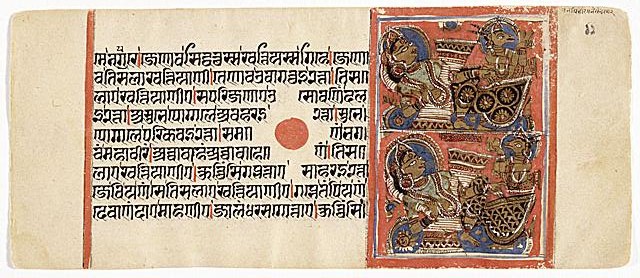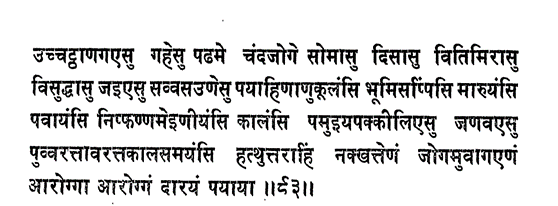 Paryushana (Paryuṣaṇa – पर्युषण) or Pajjusana (Pajjusaṇā – पज्जुसण) in Prakrit (प्राकृत) is the most celebrated festival of the Jains across the world. The Shwetambara (Śvetāmbara – श्वेतांबर) sect of Jains celebrates it over a period of 8 days, while the Digambara (दिगंबर) sect observes the Paryushana (पर्युषण) or the Dashalakshana (Daśa lakṣhaṇa – दशलक्षण), over a period of 10 days, after the completion of the festival for the Shwetambara sect.
Paryushana (Paryuṣaṇa – पर्युषण) or Pajjusana (Pajjusaṇā – पज्जुसण) in Prakrit (प्राकृत) is the most celebrated festival of the Jains across the world. The Shwetambara (Śvetāmbara – श्वेतांबर) sect of Jains celebrates it over a period of 8 days, while the Digambara (दिगंबर) sect observes the Paryushana (पर्युषण) or the Dashalakshana (Daśa lakṣhaṇa – दशलक्षण), over a period of 10 days, after the completion of the festival for the Shwetambara sect.
This festival urges all followers of Jainism to take a break from their usual busy lives and devote themselves to spiritual and religious pursuits. Also known as Parvadhiraja (Parvādhirāja – पर्वाधिराज) or Mahaparva (Mahāparva – महापर्व), it is unique in the sense that it celebrates Tapa (तप) – fasting, Prayashchitta (Prāyaścita – प्रायश्चित्त) – atonement and Kshamapana (Kśamāpanā – क्षमापना) – forgiveness, with pomp and gaiety. Mind and soul over body is the mainstay of the observance of Paryushana.
Celebrating the Birth of Bhagwana Mahavira
Of these 8 days, the second most important day during Paryushana falls on the 5th day, when the birth of Lord Mahavira (Mahāvīra – महावीर) is celebrated. Though the actual tithi (तिथि) – date of the Lord’s birth falls in the month of Chaitra (Caitra – चैत्र) March – April, it is this celebration of the birth of Lord Mahavira, which is the grandest event of the 8-day festivities.
Dressed in their finest, the Jain shravaks (śrāvakas – श्रावक) and shravikas (śrāvikās – श्राविका) – laymen and laywomen that make up the Jain congregation, throng the Upashrayas (Upāśrayas – उपाश्रय) or the prayer hall residences of the Jain sadhus and sadhvis – monks and nuns, to listen to the Mahavira Janma Vanchan (जन्म वांचन) – the reading of the events leading up to the birth of Lord Mahavira. This reading is done from the Kalpasutra (कल्पसूत्र) – the best known text of the Shwetambara Jain canonical literature.
Listening to the Kalpasutra
The Kalpasutra can be read during the Paryushana festival by the clergy – both monks and nuns and in their absence by the laymen and laywomen. On the 3rd day, it is taken around in a procession with a lot of pomp and gaiety by the members of the Jain sangha (संघ) – community and then reverentially handed over to the monks, to be read from the 4th day onwards.
The 5th day is the most anticipated day of the entire 8-day festival because it is the day the Jain congregation celebrates the birth of Lord Mahavira. The highlight of the festivities is the display of the 14 auspicious dreams which are seen by the mother, when a Tirthankara (Tirthaṅkara – तीर्थंकर) is conceived. The members of the sangha try to outbid one another to worship the silver replicas of these 14 dreams and display them to the entire congregation. The money raised thus is used to fund the upkeep of the derasar (देरासर) – Jain temple and the performance of various religious activities throughout the year. In the midst of enthusiastic bidding and devoted darshan, at a pre-determined auspicious time, the events occurring on the day of Lord Mahavir’s birth are narrated or read from the Kalpasutra by one of the senior monks.

Public Domain
The Kalpasutra (Kalpasūtra – कल्पसूत्र) starts with the description of the life of Lord Mahavira (1). The Lord was first conceived in the womb of a Brahmin lady – Devananda (देवानंदा), who sees the auspicious dreams. However, in an interesting twist in the tale, after 82 days in Devananda’s womb, the embryo is switched with that in the womb of Queen Trishala (Triśalā – त्रिशला), on the orders of Śakra (Śakra – शक्र) – the King of the Gods. The reasoning given is that the Arhats (अर्हत) – are not born into poor or brahmanical families but in noble and royal families. The 14 auspicious dreams make an appearance again, now seen by Queen Trishala. Also described in the Kalpasutra are the exact astrological and climatic conditions at the time of the birth of the Lord (2).
The original text in Prakrit is appended below (3).


The English translation of the exact moment of the birth of the Lord, as described in the Kalpasutra (Sutra 93) is produced below (4) –
“Then, at the proper time and the proper moment, Shramana Bhagwana Mahavira (Śramaṇa Bhagavān Mahāvira), when nine months, seven and a half days had passed, on the thirteenth of the bright-half (शुक्ल पक्ष) of the Chaitra, that is the second fortnight of the first month of summer, at midnight, when the previous night was just giving way to the night following and the moon was in conjunction Uttaraphalguni (Uttarāphālgunī) constellation, when all the planets were exalted, when the moon was in its best conjunction, the skies were tranquil, pure and bright, all omens augured well for success, a cool, fragrant soft breeze blowing from the southern direction swept the earth, the fields were ripe with grain and the people rejoiced and made merry, came forth into this world with the mother (Queen Trishala) giving birth to a healthy child with ease (in good health).” (5)
Once these words are uttered, the entire audience starts clapping, dancing, clanging metal plates and rocking the symbolic cradle on display, in joyous celebration of the most influential Tirthankar in recent times. This is followed by a community meal called Swami Vatsalya (स्वामी वात्सल्य) for all attendees, in accordance with the food restrictions (no vegetables and fruits) that are followed for the entire period of 8 days.
The family that has been awarded the bid for the cradle takes it home, with the silver replicas of the 14 dreams and arranges to have Bhakti (भक्ति) – singing of hymns in praise of the Lord, after the Pratikraman (Pratikramana – प्रतिक्रमण) ritual. Thus, ends a day of pomp and splendour in a festival that is otherwise characterised by restraint and withdrawal of the senses from external stimuli.
Fasting for Spiritual Rejuvenation
Another inseparable tradition of the Paryushana festival is the Tapa (तप) – fasting by the faithful. Fasting during these 8 days is venerated and eulogised. A Jain fast starts just before sunset on the eve of the fast, continues throughout the next day (drinking only boiled water 48 minutes after sunrise to sunset) and ends on the day after the fast, 48 minutes to 1 and ½ hours after sunrise. A family considers it a privilege to have one of its members fasting for 8 days, known as the Atthai (अट्ठाई). There are many who fast for 16 days, 30 days and even 45 days at a stretch! This is an amazing feat of belief and will-power that enhances the spiritual fervour of the entire congregation.
You can also read another piece on Paryushan by clicking this link: Paryushan Mahaparva
Seeking Forgiveness from One and All
 The 8 days of festive fervour culminate in the most important day of Paryushana – Samvatsari (संवत्सरी), the annual day of Forgiveness. The Samvatsari Pratikraman is an expiatory ritual whose objective is to ask for forgiveness from those one has hurt, knowingly or unknowingly, by thoughts, words and deeds. During the ritual, members of the sangha ask one another for forgiveness, saying “Micchhami Dukkadam (मिच्छामि दुक्कडम्) – May my evil deeds be fruitless”. Jains then approach their family members, relatives, friends, neighbours, acquaintances etc. and repeat this phrase, seeking their forgiveness too. The cleansing of the body by fasting is succeeded by the cleansing of the mind and soul via the Samvatsari Pratikraman and Micchhami Dukkadam.
The 8 days of festive fervour culminate in the most important day of Paryushana – Samvatsari (संवत्सरी), the annual day of Forgiveness. The Samvatsari Pratikraman is an expiatory ritual whose objective is to ask for forgiveness from those one has hurt, knowingly or unknowingly, by thoughts, words and deeds. During the ritual, members of the sangha ask one another for forgiveness, saying “Micchhami Dukkadam (मिच्छामि दुक्कडम्) – May my evil deeds be fruitless”. Jains then approach their family members, relatives, friends, neighbours, acquaintances etc. and repeat this phrase, seeking their forgiveness too. The cleansing of the body by fasting is succeeded by the cleansing of the mind and soul via the Samvatsari Pratikraman and Micchhami Dukkadam.
Paryushana is an unusual festival that lauds fasting and rasa tyaga (giving up of taste), commemorates the birth of Lord Mahavira and extols the virtues of seeking of forgiveness with the forgiveness prayer.
Khamemi Save Jeeva Savve Jeeva Khamantu Me
Mitti Me Savva Bhuesu Veram Majjham Na Kenai
खामेमि सव्वे जीवा सव्वे जीवा खमन्तु मे |
मित्ती मे सव्वभूएसु वेरं मज्झं न केणई | |
I forgive all living beings, may all living beings forgive me.
My friendship is with all living beings, my enemy is totally non-existent.
References
[1] Jacobi Hermann, Gaina Sūtras Part I, Translated from Prākrit, The Clarendon Press, Oxford, 1884, p. 217
[2] Ibid. p.251
[3] Bhadrabahu, Kalpasutra, Editor & Hindi Translator Mahopadhyaya Vinaya Sagar, All India Press, Pondicherry, 1984, 1.140,142
[4] Ibid. p. 141
[5] Ibid. p.143


Wowtastic. Very beautifully written expressing lucidly the spritual depth for tne common man to.understand the vadtness and tne meaninfulness of this religion. Wonderful
Thanks for Sharing… It was enlightening.
🙏
Very well articulated especially for the gen-next. Keep it up Geetanjali 👍
Wow, that’s a lot of effort you have put in to presenting this article. Wonderful and you rock, my beautiful sister!😘
Excellent very informative. proud of you
Impressive … Thorough informative and explanatory article in super interesting way. Really commendable.I appreciate your sanskrit learning from scratch and reached this level and still your gesture to describe it as beginner.
Hi Gitanjali
Very nice article .Thank you so much for sharing this .
Since long time I was also ज्ञातुमुत्सुका about Paryushan
Thank you for a very enlightening blog on Jainism and practices which is not very well understood by many in india. Great articulation of the Jain traditions makes this an excellent read. Your versatility of the languages, traditions comes out clearly and so does your interest in ancient texts. Best wishes – for your efforts to continue to enlighten us !